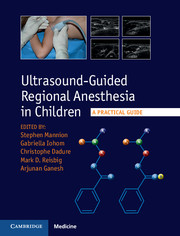Book contents
- Frontmatter
- Contents
- List of contributors
- 1 Introduction
- Section 1 Principles and practice
- Section 2 Upper limb
- Section 3 Lower limb
- Section 4 Truncal blocks
- 14 Ultrasound-guided ilioinguinal/iliohypogastric block
- 15 Ultrasound-guided transversus abdominis plane block
- 16 Ultrasound-guided rectus sheath block
- 17 Ultrasound-guided paravertebral block
- Section 5 Neuraxial blocks
- Section 6 Facial blocks
- Appendix: Muscle innervation, origin, insertion, and action
- Index
- References
14 - Ultrasound-guided ilioinguinal/iliohypogastric block
from Section 4 - Truncal blocks
Published online by Cambridge University Press: 05 September 2015
- Frontmatter
- Contents
- List of contributors
- 1 Introduction
- Section 1 Principles and practice
- Section 2 Upper limb
- Section 3 Lower limb
- Section 4 Truncal blocks
- 14 Ultrasound-guided ilioinguinal/iliohypogastric block
- 15 Ultrasound-guided transversus abdominis plane block
- 16 Ultrasound-guided rectus sheath block
- 17 Ultrasound-guided paravertebral block
- Section 5 Neuraxial blocks
- Section 6 Facial blocks
- Appendix: Muscle innervation, origin, insertion, and action
- Index
- References
Summary
Clinical uses
The ilioinguinal nerve is blocked in conjunction with the iliohypogastric nerve in the pediatric population to provide ipsilateral analgesia for inguinal and scrotal surgery. The technique is utilized for procedures including inguinal hernia repair, orchidopexy, or varicocelectomy. It is used as an analgesic adjunct to general anesthesia. The successful ilioinguinal/iliohypogastric block (ILIHB) provides long-lasting analgesia as well as reducing opioid consumption and opioid-related side effects. However, it is not sufficient to completely eliminate the visceral pain associated with peritoneal traction or manipulation of the spermatic cord or testes.
Developed in the 1980s, ILIHB was initially performed using anatomic landmarks and the “fascial click” method. However, a failure rate of up to 40% is reported with the landmark technique. This is mainly as a result of the high variability of pediatric anatomy, poorly defined landmarks, and intramuscular deposition of local anesthetic (LA). The introduction of ultrasound-guided techniques has achieved success rates of up to 95% and it is now regarded as the gold standard (Willschke et al., 2005). Ultrasound-guided ILIHBs also lower the dose required to achieve appropriate analgesia and reduce the complication rate. The use of lower doses of LA has particular relevance in neonates because of their increased risk of toxicity resulting from lower levels of alpha-1 acid glycoprotein (AAG) with subsequent reduced protein binding (Polaner and Drescher, 2011).
ILIHB can be as effective as the caudal block for post-operative analgesia and is accepted as a useful alternative (Markham at al., 1986). It has also been shown to establish superior levels of analgesia compared to the transversus abdominis plane (TAP) block for inguinal surgery (Bhalla et al., 2013).
ILIHB in children appears to be very safe. Overall, a complication rate of 1:1000 with no long-term consequences has been reported (Lönnqvist, 2010; Willschke at al., 2010). General complications include intravascular injection, infection, intraneural injection with subsequent nerve damage, and failure of the block to achieve the required analgesia. Specific complications are intraperitoneal injection, bowel perforation, hepatic injury, femoral nerve palsy, and pelvic hematoma. The distance between the deepest muscle layer, the transversus abdominis, and the bowel is minimal, further stressing the importance of an ultrasound-guided technique.
- Type
- Chapter
- Information
- Ultrasound-Guided Regional Anesthesia in ChildrenA Practical Guide, pp. 101 - 105Publisher: Cambridge University PressPrint publication year: 2015



